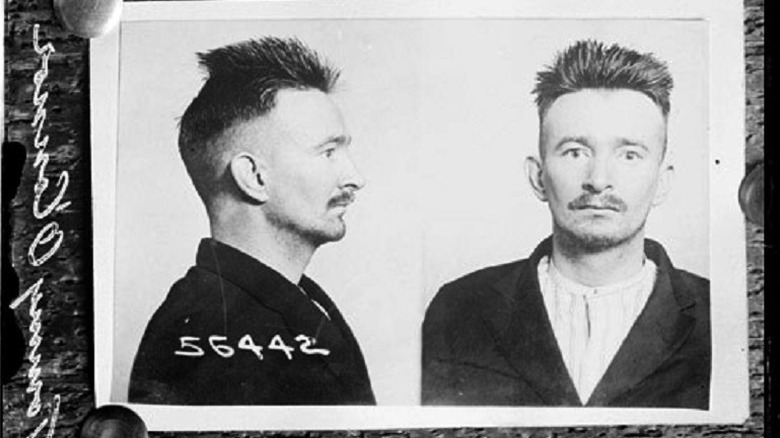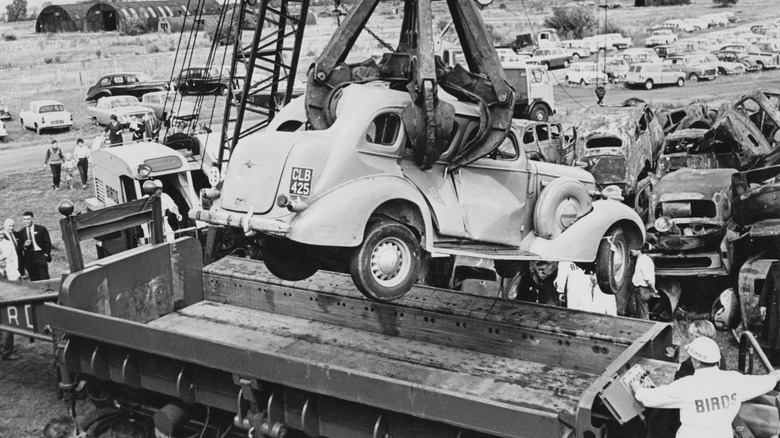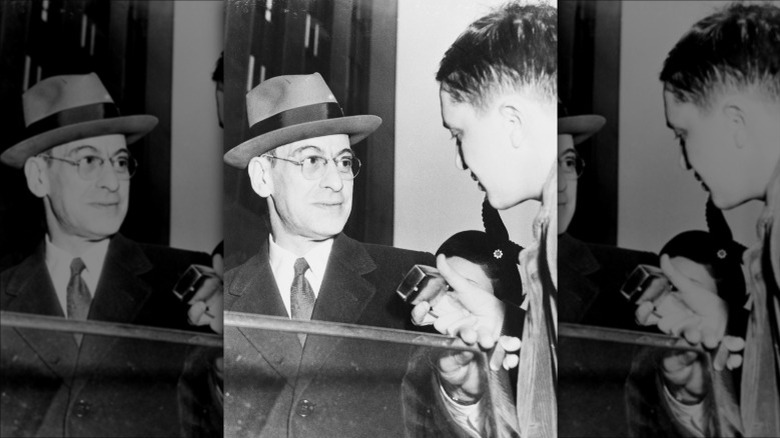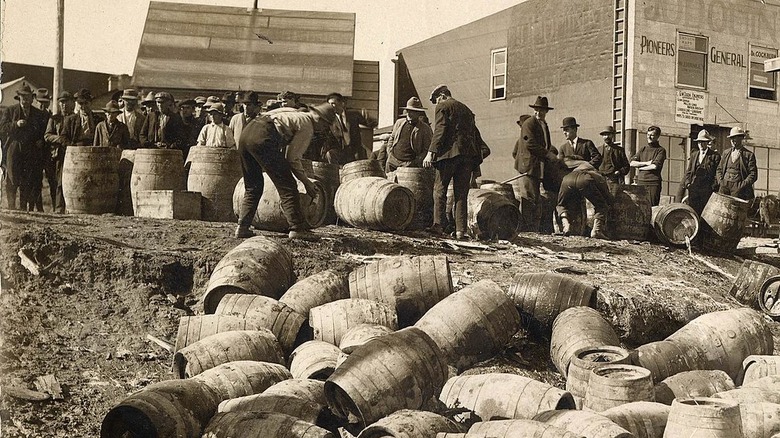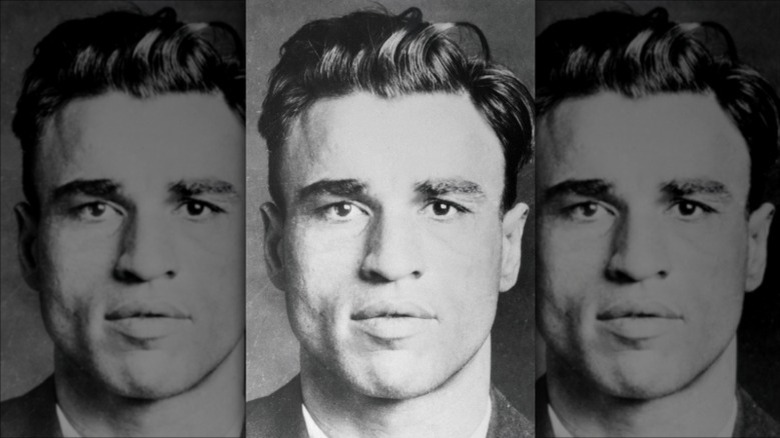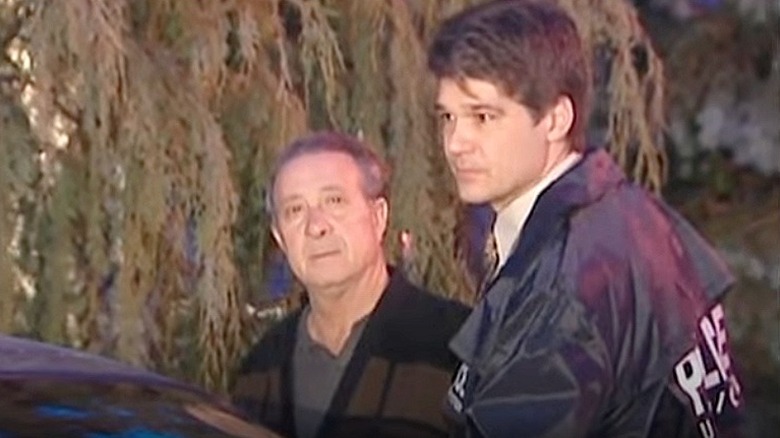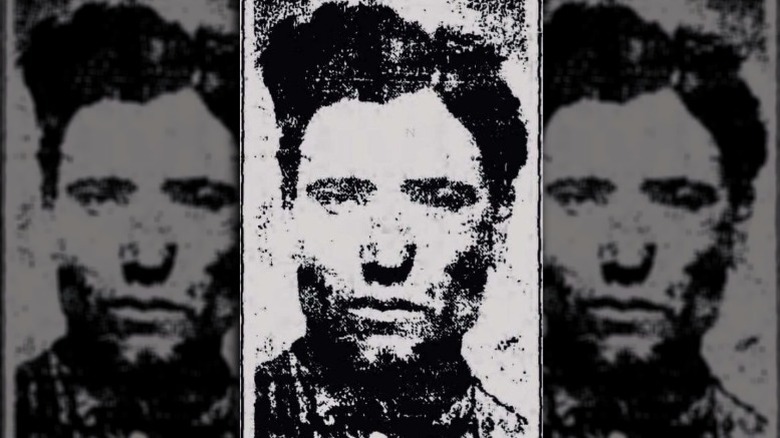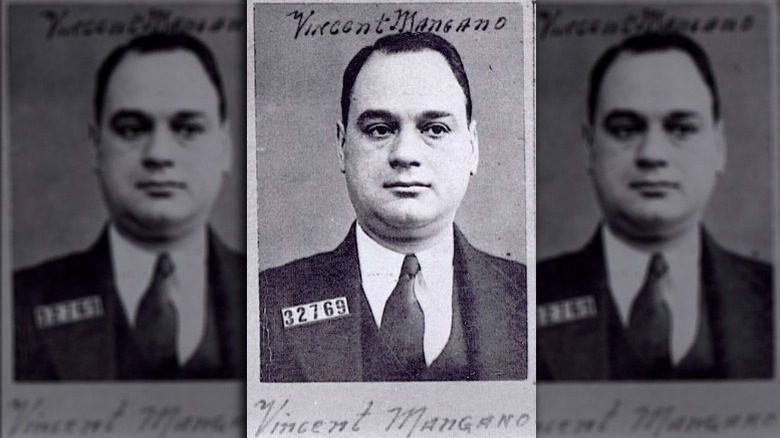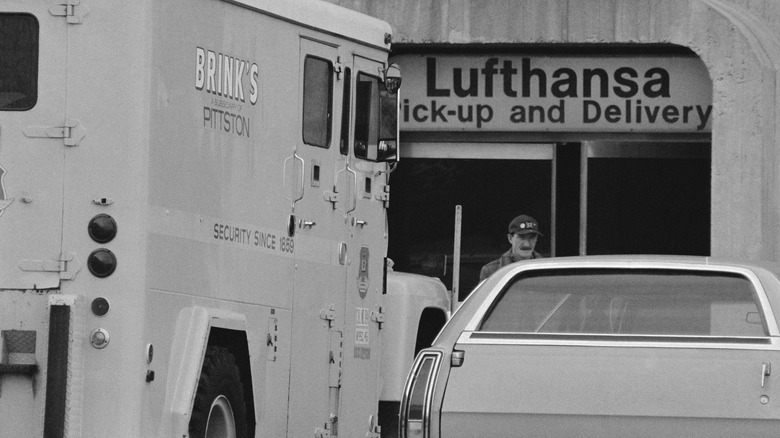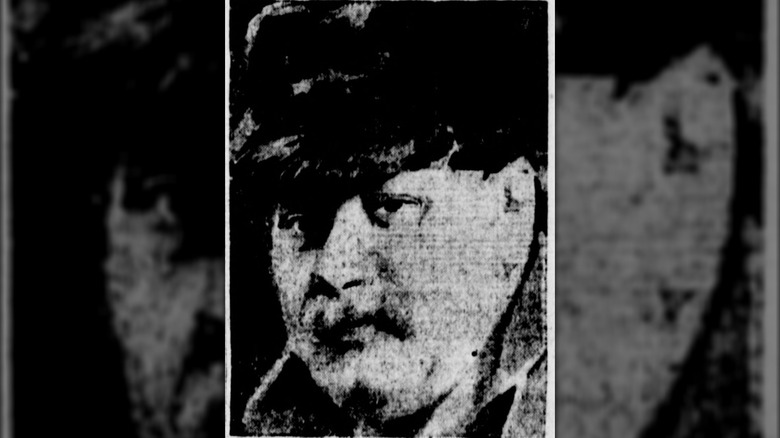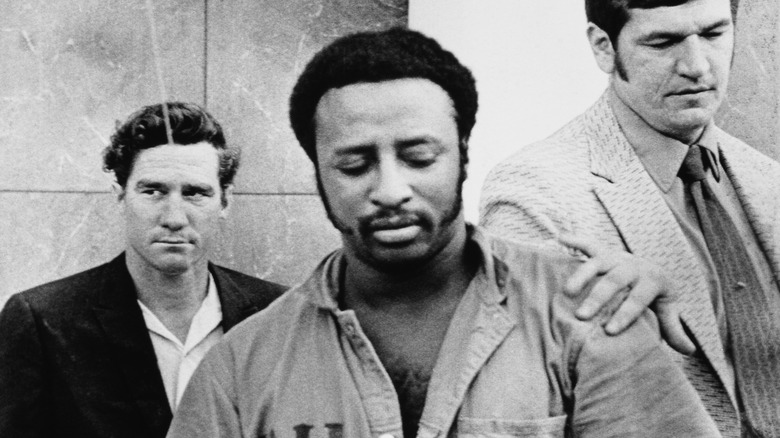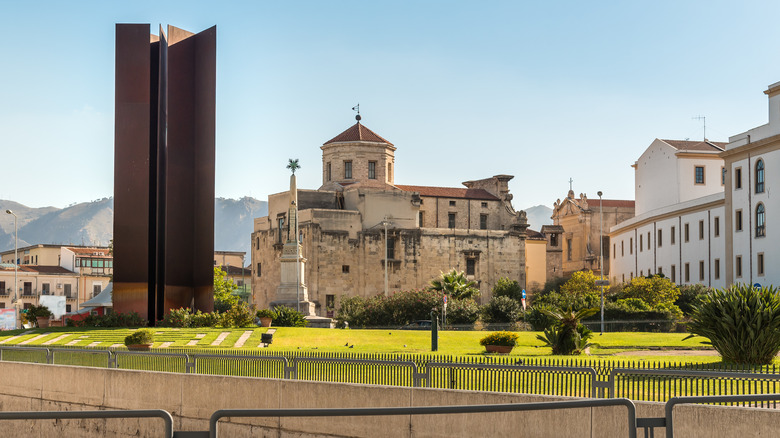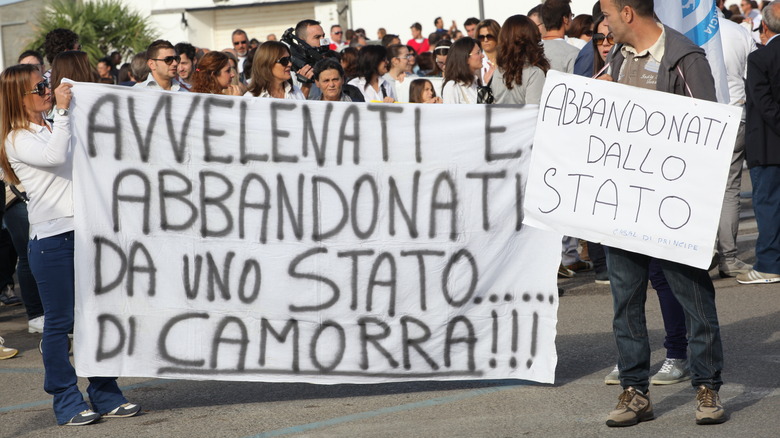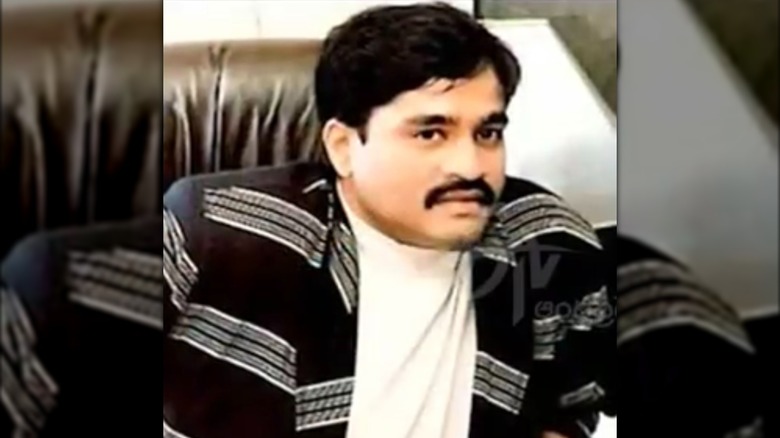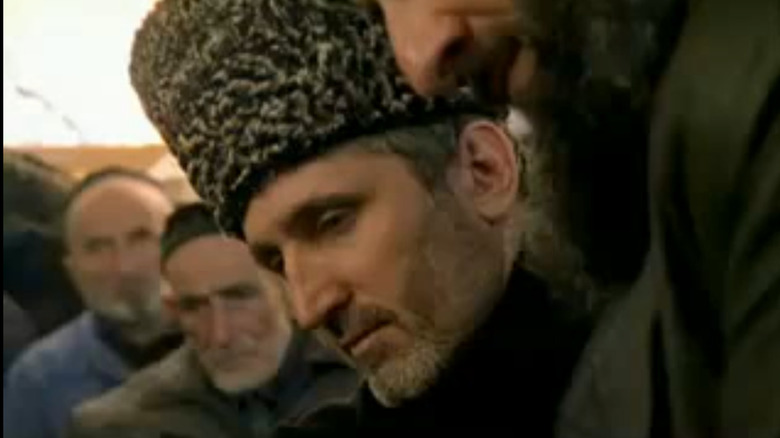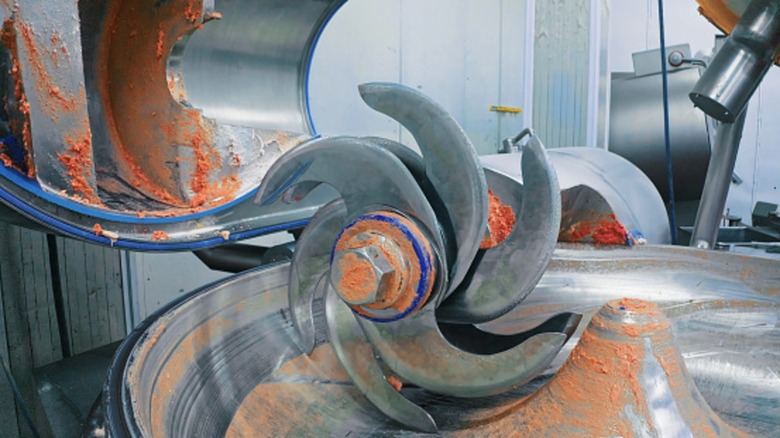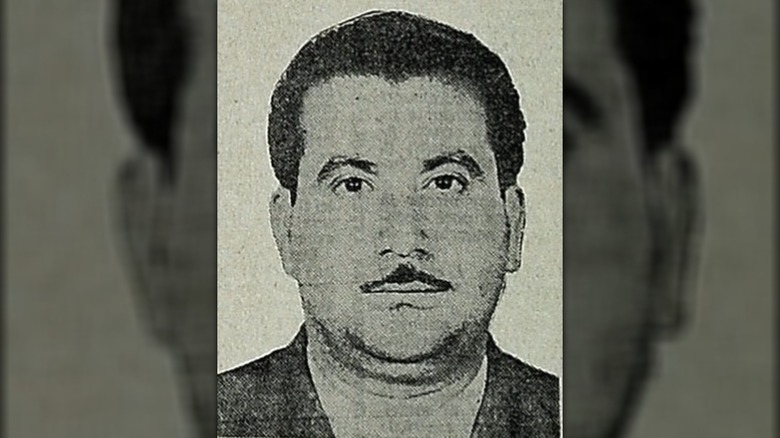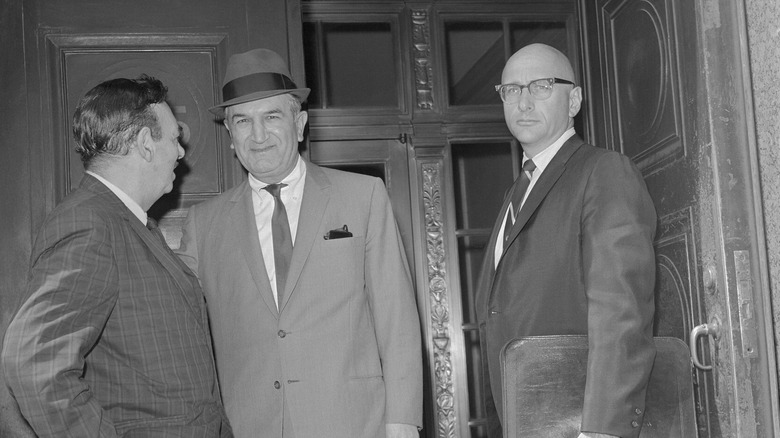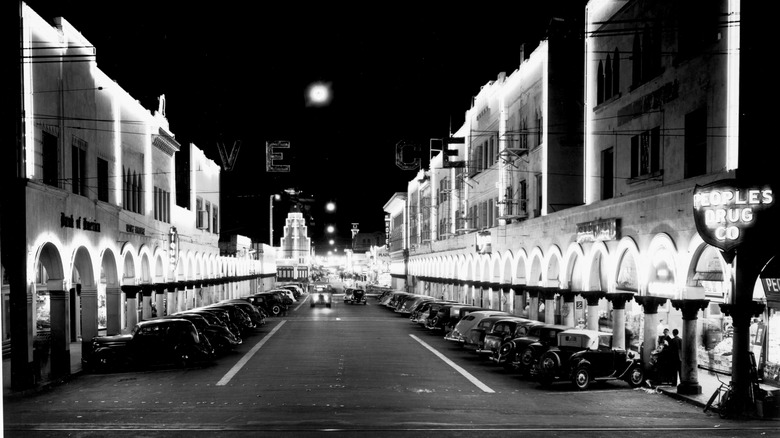Gangsters Who Vanished And Were Never Found
When high school guidance counselors discuss possible career paths, "gangster" doesn't usually come up. Getting a job in the underworld, or Mafia, or whatever you want to call it, is always a dangerous prospect. A lot of times, it can be a job for life; as in, you could totally lose your life because of your job. Not many famous gangsters died in their sleep of old age. Usually they go out violently, killed by their enemies, the government, or even their own men.
Then there are the gangsters whose ends are less clear, because they just straight-up disappeared. Usually, it's probably because they too were killed horribly, but no one can be completely sure, since their bodies have never been found. Maybe some of these guys managed to get out of the mob, create a new life, and live happily on a farm somewhere surrounded by grandchildren. Nah, it was probably the violent murder thing.
Tommy O'Connor
While Chicago gangster Thomas O'Connor picked up the sobriquet "Terrible Tommy" somewhere along the way, in 1962, The Lakeland Ledger sniffed that he "wouldn't rate a line alongside the Dillingers and Capones and Baby Face Nelsons." That gives you an idea of his level of gangster cred. However, his vanishing act managed to impress.
In 1921, O'Connor was on death row in the Cook County jail, sentenced to hang for killing a police officer. Four days before the scheduled execution, he escaped by getting ahold of a pistol and threatening a guard. He stole a car (the fourth one he commandeered, after abandoning the first three for some reason) and was never seen again. According to The Washington Post, there were plenty of theories about what happened to O'Connor, including he "returned to his native Ireland to fight the British, fled to Mexico or became a Trappist monk." There's a grave in Illinois reputed to be his, but it's almost certainly a different Thomas O'Connor.
O'Connor's disappearance was a problem for Chicago. Cook County "discontinued hanging" and moved on to the electric chair in 1927. But Terrible Tommy's sentence specified he was to be hanged. That meant if he ever turned back up, they couldn't legally kill him any other way. So, just in case, the gallows gathered dust in a basement until 1977, when the county finally gave up on killing O'Connor, who would have been 96, and sold it.
Anthony Zizzo
His 5'3" height earned mobster Anthony Zizzo the nickname "Little Tony," although he managed to pack 200 pounds on that small frame, according to ABC 7. He was a member of the Chicago Outfit, the Italian-American mafia in that city. In 2006, a major mob trial was about to begin, but Zizzo "conspicuously wasn't charged." There's a theory this may have made him look like a snitch. He was also in the middle of an intense beef with the powerful gangster Michael Sarno over a video poker machine business. So it wasn't that surprising when he suddenly vanished.
On August 31, Zizzo left his house, telling his wife he had a business meeting. He stopped for gas and went to a restaurant, where he was seen by numerous employees, but never reached the restaurant. His car was later found in the parking lot, but Zizzo was gone. There were no signs of foul play. His wife filed a missing person's report, and the FBI eventually offered $10,000 for information.
Many people think he was murdered, either by his own crew for the rumors he'd snitched to the government, or by his nemesis Sarno. One mob expert says he was probably killed and his body "disposed of in a manner that would make it nearly impossible to locate." However, Sarno, who is in prison on unrelated charges, as of this writing, swears he had nothing to do with Zizzo's disappearance. And the FBI thinks it's possible Zizzo went on the run to avoid possible prosecution.
James Squillante
Certain occupations have reputations for being mobbed-up. If the Mafia can get a monopoly on something, they acquire more control and lots of money, which is kind of their raison d'être. In mid-20th century New York City, garbage collecting was one of the Cosa Nostra's main rackets. In 1957, a Senate committee revealed a 5'1" fruit-peddler-turned-gangster named Vincent James Squillante was "the absolute czar of the private sanitation industry in Greater New York," according to "Gotham Unbound: How New York City Was Liberated from the Grip of Organized Crime." But Squillante wasn't just the business side of things. That same year he was alleged to have ordered his goons to kill a guy and cut him up into tiny pieces, as reported by a later Senate committee.
Being investigated by the Senate is never a good sign. It means the law is on to you. In 1960, Squillante was indicted on extortion charges. On September 23, he was seen driving a new Chevy, then he vanished. He may have been murdered by the mob for "personal misconduct," or so he couldn't squeal at trial. While no one knows for sure what happened to him, there is a rather disturbing rumor. One account claims he was shot in the head and his body loaded into the trunk of a car. The automobile was then smooshed in a crusher and finally melted down in a furnace, with Squillante's body still inside.
Anthony Strollo
Mafia guys get nicknames, and Anthony Strollo's was the fabulous "Tony Bender." He was an important guy, the right-hand man of New York mob boss Vito Genovese for many years, according to "The Mafia Encyclopedia." He was well trusted, even being placed in charge of operations when his boss had to flee to Europe in the 1930s, and he ordered more murders than possibly any other mobster. Being Strollo's friend didn't mean much. In once instance, Genovese made sure Strollo wasn't involved in a hit, since the target was Strollo's best friend, but Strollo "cheerfully volunteered" to help when he found out about the plans. Years later, he tried to kill another friend as well.
Strollo's loyalty was just as flexible as his friendships. He tended to align himself with whomever had the most power at the time. In 1958, he switched families and set up his old boss Genovese in a drug bust. The mob boss went to jail, where he realized Strollo had betrayed him.
On April 8, 1962, Strollo left his home, telling his wife he would only be gone a few minutes. He was never seen again. There are rumors he's under the West Side Highway, or that his body was dumped in a cement mixer and became part of a skyscraper. "The Complete Idiot's Guide to the Mafia" reports that when asked why Strollo vanished, Genovese vaguely alluded to ordering his murder, saying it had been a kindness, since Strollo wouldn't have been able to handle prison.
Danny Walsh
An Irish-American guy from small-town Rhode Island doesn't sound like your stereotypical gangster. But Prohibition had a way of turning even regular people into criminals. According to the New England Historical Society, Danny Walsh was making $5 a day when alcohol was outlawed in America. He decided this rum-running racket would be a better way to get rich, especially since there was little chance of getting in trouble for it in a state that was against Prohibition and never approved the 18th Amendment.
Walsh became one of the biggest bootleggers in the U.S. He only had one small brush with the law over unpaid taxes, however, his new job required he get close to organized crime bosses, including "King" Charles Solomon and associates of Al Capone. This put him in danger, especially as the liquor business became more violent. In 1933, Walsh had a dinner with friends, later dubbed his "death supper." Then he vanished. Walsh's brother received a ransom note demanding $40,000. The money was handed over to an anonymous guy in Boston who "[slipped] his hand through a hotel room door." Despite the kidnappers' promise, Walsh wasn't returned, dead or alive.
Court TV's Crime Library reports an inquiry held after Walsh's disappearance failed to figure out what happened. One rumor was that he'd been buried on his own farm, while another said his body was "stuffed into a barrel of cement" and dumped in the ocean. For decades, any suspicious corpse was compared to Walsh's dental records, but they never matched.
Frederick Tenuto
By the time he was 16, Fredrick Tenuto already had a criminal record, according to "The Mafia Encyclopedia." But his continuous trips to prison weren't that big a deal to him, because Tenuto was extremely good at breaking out. A history of Eastern State Penitentiary records shows he managed two escapes — one from there, and one from another prison no one had ever broken out of before. While he wasn't an important mobster, Tenuto got the nickname "Angel of Death" because he was a go-to guy if you wanted a hit done. He was even added to the FBI's Most Wanted list in 1950. But his carelessness would be his downfall.
Albert Anastasia was a mafia don and properly insane. His answer to everything was violence and murder. When a man named Arnold Schuster did his civic duty and turned in a bank robber in 1952, American Mafia says Anastasia announced he hated squealers and ordered Schuster killed. The job fell to Tenuto. The Angel of Death did the deed in the open on a New York Street, and there was at least one witness. When Anastasia heard his triggerman had been seen, he panicked. Tenuto could be connected to him, so he ordered his hit man killed to clean up the messy situation.
Tenuto vanished, almost certainly because he'd been murdered, but his body was never found. Some police informants said he'd been given a "double-decker funeral," which is when a body is placed in a false bottom underneath a different corpse.
Abraham Weinberg
Abraham "Bo" Weinberg entered the world of organized crime as a young man, and by the time Prohibition rolled around, he was working for major New York bootlegger Dutch Schultz. Weinberg rose to be his right hand man, personally killing many of Schultz's competitors and running his empire when Schultz went on the run to avoid tax evasion charges, according to Hollywood Most Wanted.
But the book "Dutch Schultz: The Brazen Beer Baron of New York" reports the feds were getting close, and this concerned Weinberg. He liked his money and power, and if his boss fell, he risked losing it all. So Weinberg conspired with rival Lucky Luciano, giving the other mob boss tips on how to bring down his current don in exchange for "a healthy cut of any future action." But before Luciano could move in and take over, Schultz found out about Weinberg's betrayal.
On September 9, 1935, Weinberg left a friend's house, got in a car, and was never seen again. While one story says Schultz killed his Judas "with his bare hands," it's the more common tale of his murder that went down in history. After being beaten almost senseless, Weinberg's feet were encased in cement and he was dumped in the East River while still alive. Vice says that this was where the Mafia stereotypes of "cement shoes" and "sleeping with the fishes" originates from, and it may very well have happened to Weinberg, even if they never did it again.
Rocco Perri
America wasn't the only place that banned alcohol for awhile. Ontario also got in on the not-fun with the Temperance Act of 1916, which was pretty much a blanket ban against booze. That meant you got (assumedly very polite) northern gangsters involved in bootlegging. And the "Al Capone of Canada" was Rocco Perri, according to The Hamilton Spectator.
The Toronto Star reports that one night in 1923, Perri, the "patriarch of the mob," was on the scene as more than 2,500 bottles of whiskey were unloaded from a boat. The cops busted him, but Perri swore he was just in the area and had nothing to do with it. The charges were eventually dropped. A year later, he wasn't so shy about his work. In 1924, Perri confessed his illegal activities to a reporter, and his wife called him the "king of the bootleggers." But he couldn't be charged with anything just for bragging.
On April 23, 1944, Perri got a headache while visiting a cousin. He went for a walk to try and shake it, saying he'd be back by lunch. He never returned. There's a theory that he was murdered by underworld rivals for control of his territory and dumped in Hamilton Harbour, but there is some evidence he might have learned about a plot to kill him and fled. Perri's biographer claims to have proof he lived in Massena, New York, under the name "Giuseppe Portolesi" until he died of natural causes in 1953.
Paolo Renda
Canada has a surprisingly active and violent underworld, and Paolo Renda was right in the middle of it. In the 1970s, Nicolo Rizzuto took over the Mafia in Montreal by killing another don, according to the CBC. Renda married Rizzuto's daughter and got heavily involved in the family business, including handling the finances.
Renda had numerous run-ins with the law. The Globe and Mail reports that in 1972 he was convicted of arson, 2006 saw him arrested in a huge mob raid, and in 2008, he pleaded guilty to "two counts of possessing profits from organized crime." Things also started to go south for his mob family in general. A rival gang began fighting them for power, sending messages that included kidnapping Rizzuto's gangsters, who would later reappear safe and sound.
That wasn't the case for Renda. On May 20, 2010, while he was on conditional release from jail, construction workers saw a black car with a removable siren on top pull the gangster over. Two men posing as plainclothes police officers bundled him into their car. His wife discovered Renda's SUV abandoned with the keys still in the ignition. He was never seen again. The real police thought the hit might have been part of a vendetta dating back to the 1970s. Normally it takes seven years to declare someone dead when they vanish, but Global News says Renda's wife tried to get closure in 2013. The judge rejected her petition, saying there wasn't enough proof he'd been killed.
Joseph Ardizzone
Joseph Ardizzone was a man of many faces. He was an immigrant fruit peddler, just trying to make a living in turn of the century LA, according to Gangster Squad: Covert Cops, the Mob, and the Battle for Los Angeles. He was also a civic leader in the Italian community, according to The Los Angeles Sugar Ring: Inside the World of Old Money, Bootleggers & Gambling Barons.
But there was another, more murderous side to Ardizzone. Hard-Boiled Hollywood: Crime and Punishment in Postwar Los Angeles says two gangs emerged in LA, with Ardizzone heading one. The Black Hand started killing people in their rival mob (drive-by shootings were done on bicycles at the time), and by 1906, Ardizzone had to go on the lam. But soon he was back in LA, and back to his old habits. When Prohibition rolled around, he got involved in bootlegging like all gangsters. And he kept killing people, although the law never got any murder charges to stick. He once bragged he'd killed 30 men.
But the violence of the liquor business caught up to Ardizzone. He wanted to muscle in on other gang's bootlegging operations, and they wanted to take over his. He was shot in a drive-by in February 1931, and barely survived. Then in October, he went for a drive to go pick up a cousin but never arrived. No one ever found out what happened to him. His wife had to wait years until he was officially declared dead.
Vincent Mangano
While not as famous these days as mob bosses like Al Capone and Lucky Luciano, in the 1920s and '30s, Vincent Mangano commanded just as much respect as head of his crime family. An immigrant from Sicily, by 1931, he was in charge of the Brooklyn Mafia, with his brother Philip serving as his second in command.
National Crime Syndicate reports that Mangano, while known as "The Executioner," believed in doing things the old way. He "followed the rules of honor, tradition, respect, and dignity," even when that meant killing people. One of his underlings agreed, writing in "A Man of Honor: The Autobiography of Joseph Bonanno" that Mangano thought it was his responsibility to guide his "sons" in the correct way of doing things, so the mob didn't lose its traditions.
Unfortunately for Mangano, one of his underlings was Albert Anastasia, who was, as previously mentioned, completely insane. Anastasia also wanted to be in charge. According to the book "Mafia Summit: J. Edgar Hoover, the Kennedy Brothers, and the Meeting That Unmasked the Mob," Mangano and Anastasia often had "heated arguments" in public. Sometimes it turned physical. In 1951, Anastasia was overheard plotting against his boss. On April 19, second-in-command Philip Mangano was found murdered in a swamp. When police came to question his brother about the death, Vincent Mangano was nowhere to be found. While Anastasia denied involvement, it's believed he had both brothers killed on the same day. Anastasia got what he wanted and took over the family.
David Carroll
David "Wolf" Carroll was a Canadian gangster, whose biker gang changed names and affiliations several times, but which was known for its particularly over-the-top violence. In 1985, Carroll was one of six Hells Angels charged with killing five members of a different chapter of the gang for ripping them off. However, all of the defendants were found not guilty. Carroll got lucky again in 1988, when he was acquitted of murdering a young man. Soon he was too high up in the organization to get his hands dirty and instead started ordering others to do the killing for him. It's believed he was involved in the killings of at least 13 people.
In 2001, when police moved in on his gang, Carroll managed to escape. He hasn't been seen since. According to his wanted poster, Interpol believes Carroll has traveled widely while on the lam, including to Brazil, Mexico, Australia, New Zealand, South Africa, and the United States. A major search for him in 2009 failed to find the fugitive, as did another in 2010. Authorities were hopeful for a lead in 2012, when another fugitive Hells Angel was apprehended in Panama after being on the run for three years, but if there was a connection between the men, it clearly did not help the authorities find Carroll. In 2020, a Hells Angel on trial for murder swore under oath that while he did have a connection to Carroll, he had no idea where the fugitive was.
Tommy DeSimone
Tommy DeSimone has the dubious honor of being the real-life gangster that Joe Pesci's character is based on in "Goodfellas." If you have seen that classic film, you know what happens to that character, so the fate of DeSimone is not exactly mysterious, even if there is no proof of what happened to him after he disappeared.
DeSimone was not a nice guy, to say the least. He was a murderer who also allegedly tried to rape a friend's wife. But what mattered much more to his mafia pals was that he bungled a major robbery. In a mafia story that seems too wild to be true, in 1978, mobsters undertook an audacious heist of the Lufthansa cargo vaults at JFK Airport. Because they expected to find $20 million in gold, jewels, and cash, it was determined they needed two vans. DeSimone was supposed to get the second van. He failed, meaning they could only get half the loot. He also lifted his mask during the heist, allowing a witness to see his face. After that, he was a dead man.
DeSimone's wife reported him missing in January 1979, and he was never seen again. According to the real-life Henry Hill, who cowrote the book that "Goodfellas" was based on, DeSimone was murdered after negotiations between some high-up mafia goons. Hill alleges that John Gotti was the one who pulled the trigger. But we only have Hill's word for what happened — and he wasn't even in New York at the time.
Sebastiano DiGaetano
Sebastiano DiGaetano was an Italian immigrant who came to New York in 1898. He originally worked as a barber, but by 1910 he had joined the mob and turned to crime. That was when he and nine others were arrested for the kidnapping of two young boys whose families were then sent ransom demands. Despite the public's fury over the crimes (police had to keep an angry mob from attacking the prisoners), and the fact DiGaetano was said to be the ringleader of a larger kidnapping operation, the charges against him had to be dropped due to lack of evidence.
DiGaetano rebounded so successfully from his arrest that he not only became the head of the mafia clan that would eventually become the infamous Bonanno Family, but within two years he had managed to become the head mafia guy in the U.S. (known as the "capo dei capi" or "boss of bosses"). The barber seems to have realized that he was in over his head, however, and quickly stepped down.
After that, no one knows what happened to him. Both he and his wife disappeared at the same time in 1912, resulting in the theory that the couple might have returned to Italy, although it is always possible they were murdered.
Iso Lero
Iso Lero, aka Džamba or "the Don of Dorćol," was a gangster in the former Yugoslavia who started his life of crime at a young age with petty theft before moving up to stealing cars. This ended up landing him in jail, where his experiences sound like a gangster film. It's claimed that he used his 160 IQ to learn the country's legal code and became a jailhouse lawyer to other prisoners, and that he was so successful at it that none of his appeals were rejected in full. It's also said that despite being small in stature he was a talented fighter who didn't back down, even to the guards, and so was often beaten. In his free time, he wrote love songs.
Once out of jail, Lero went abroad to do more crime but still had business in Belgrade. It was there that he disappeared on September 23, 1992. He was last seen at a casino in the Beograđanka building (pictured). While dozens of different versions of what happened that night circulated after his disappearance, it seems that the guards at the casino beat him bloody. While there were some rumors that he was alive, it is pretty clear Lero died that night. Other rumors said his body was either buried in secret, tossed in the Danube River, or even encased in the concrete foundation of a building on a construction site. Whatever happened, he was never seen again and his body has never been found.
Frank Matthews
Frank Matthews was just 21 when he decided he would revolutionize the drug trade. Then based in New York City, his operation would grow to encompass most of the Eastern United States. It wasn't all smooth sailing. Considering there were already criminals who controlled the distribution and sale of illegal drugs, Matthews had problems with both the Detroit drug trafficking kings the Black Mafia Family, and the Italian Mafia.
Mostly, however, Matthews was a hugely successful gangster. He ran his operation like a business, complete with employees who bagged the drugs in regular eight-hour shifts like more legitimate jobs. He made an unbelievable amount of money and showed it off in an over-the-top fashion: cars, furs, women, a huge mansion, and trips to Las Vegas. He was arrested in that city in 1973 on drug charges, and his bail of $5 million was the highest in U.S. history at that time. This amount was eventually reduced, however, and when he was extradited to New York, he posted bond and was released.
Then Matthews was gone, along with his girlfriend, a bodyguard, and an estimated $20 million. The police received several tips that went nowhere, including (allegedly) almost catching him at a bank in North Carolina and police raiding the home of a completely different man named Frank Matthews. Despite the DEA offering $20,000 — what was then one of the two highest rewards ever (ranked alongside the infamous John Dillinger) — for information, Matthews was never seen again.
Giovanni Motisi
The mafia did not start in the U.S. The criminal organization behind the American mafia originated in Sicily, and there is still a powerful mob presence on the island today. Giovanni Motisi is said to be one of the most powerful members of the Cosa Nostra — assuming he is alive, that is.
Motisi — who was saddled with an unfortunate mob nickname that translates to "Fatty" or "Plump" — is one of Italy's most wanted fugitives. In the 1990s, it's alleged he was responsible for a bombing campaign that killed 12 people, including two prosecutors. He is also accused of being involved with the murder of several police officers, among other crimes, in the '80s and '90s. Despite this, he has successfully evaded authorities since 1998.
The authorities are not giving up, however. In 2024, they released a new age progression photo that used the same technology that resulted in the capture of another Italian mob boss, Matteo Messina Denaro, in 2023. Denaro had been on the run for 30 years at the time, so capturing Motisi would not be unprecedented. Nor is there seemingly any reason to think he has been murdered, or even that he has left Sicily. And since he was born in 1959, it can't be assumed he has died of old age.
Renato Cinquegranella
Renato Cinquegranella is (or perhaps was) a member of Italy's Camorra. This is a mafia-style organization that is not the Cosa Nostra but is involved in all of the same criminal activities.
Cinquegranella is accused of giving logistical support to a terrorist organization called the Red Brigade in 1982, which resulted in the group murdering a police captain and his driver. The mobster is also believed to have been personally involved in the gang war killing of a member of a rival family: Giacomo Frattini was found in the trunk of a car in 1982, or at least, part of him was ... the other bits were found in plastic bags in the passenger compartment. The death was purposely horrific to send a message, which, if he was responsible for it, tells you that even among criminals, Cinquegranella is pretty twisted.
The mobster has been on the lam since 2002, and is one of Italy's most wanted. He has also been actively hunted by Interpol since 2018, so authorities believe Cinquegranella (who was born in 1949) is still alive. Unless he is found, he is destined to be another mobster who was never brought to justice.
Dawood Ibrahim
Dawood Ibrahim is the head of a massive, multi-billion-dollar Indian crime syndicate called "D Company" that smuggles drugs throughout much of Europe and Asia. However, while most gangsters would leave it at that, Ibrahim decided to level up to terrorism. He's wanted for his involvement in both the 1993 Mumbai bombings — which killed hundreds and injured over a thousand people – and the 2008 terrorist attacks in that same city, which resulted in an additional 174 deaths.
Through the use of drug smuggling routes in the Middle East, Ibrahim also had a relationship with Osama bin Laden. Due to this, in 2003, the U.S. government and the U.N. designated Ibrahim a supporter of terrorism, making him one of the world's most wanted fugitives and dangerous men.
Despite the fact he has been a fugitive from justice for decades, everyone seems to know where he is. Like Bin Laden before him, Ibrahim is in Pakistan. His son held his wedding there in 2011, the U.S. government claims to know Ibrahim's Pakistani passport number, and India claims to know his exact address in Karachi. Even in the face of all this evidence, the Pakistani government has always denied that the terrorist is in their country.
Khozh-Ahmed Noukhayev
Khozh-Ahmed Noukhayev has the distinction of being at once the head of the Chechen Mafia in Moscow and a notable international statesman who met Margaret Thatcher and led an independence movement. But that barely scratches the surface of this complicated gangster.
While attending law school, Noukhayev burgled the homes of students who he knew had money, which resulted in a jail sentence. Once he was released, he went into organized crime. Jailed again, his friends broke him out in 1991. At some point, he began working with — or at least with the blessing of — the Russian spy agency (which went from being called the KGB to the FSB around this time). Once he was allowed to commit crimes with impunity, his fortune grew. He chose to use that money to help fund the Chechen fight for independence.
Considering Russia thought it owned Chechnya, this finally put Noukhayev on Russia's bad side. When the author of a book on the mobster was murdered in Moscow, the FSB accused Noukhayev of the crime. But he continued fighting for his homeland, becoming head of the Caucasus Common Market and effectively acting as a shadow foreign minister. Despite being surrounded by bodyguards at all times, he disappeared sometime around 2004 and has not been seen since.
Louis Roy
Louis "Melou" Roy was a high-ranking Hells Angel in Canada, considered important enough that he was one of the founding members of the elite Nomads chapter of the group. In 1997, he was charged with murder for the killing of a rival drug dealer, but the case never went to trial.
In 2000, Roy disappeared. Authorities are pretty sure he was killed, and if he died the way it is said he did, Roy deserves to go down in the annals of the most notorious gangster murders in history. According to the court testimony of another gang member, Roy was instructed to attend a Hells Angels meeting — which just so happened to be taking place at a meat processing plant. There, he was murdered by being put in an industrial meat grinder.
Despite being missing since 2000, it was still considered a scandal when the Canadian press reported in 2015 that his former partner of 15 years, Rosalba Guerrera, was running a string of daycares. After her connection to the missing gangster was uncovered, she sold several of the businesses over the next few years.
Salvatore La Barbera
Salvatore La Barbera, along with his brother, was head of a mafia family in Palermo, Italy, but he lived differently than the mobsters who had come before him. This was the 1950s and '60s, and rather than living a quiet life of crime to stay under the radar, La Barbera was part of what was known as the "New Mafia." These young men flashed their wealth and ill-gotten gains, purposely drawing attention to their criminality. He used legitimate businesses as fronts, while behind the scenes he was heavily involved in drug trafficking. And it was a disagreement over one of his shipments of drugs that would lead to a long, bloody period of infighting between Italian mafia families.
La Barbera disappeared in January 1963, during the First Mafia War. He was almost certainly murdered, especially since his car was eventually discovered. (Sources disagree on whether the car had been burned or was pristine with the keys in the ignition. Either way, it was meant to send a message about what had happened to the mobster). The rumors were that a rival mafioso had La Barbera killed and then burned up the body in an industrial furnace. Whatever happened, La Barbera was never seen again, and his remains have never been recovered.
Frank Mari
Frank Mari arrived in New York City from Italy at 8 years old, and by his teens, he was involved in a life of crime. Local mafia members took notice of both his talent at criminality but also his respect for them: He didn't try to take over their turf, always asked for permission to pull a job, and was willing to do anything they asked him to. Eventually, his loyalty got him into the mafia officially, and he became a part of the family run by Joseph Bonanno (pictured center).
Mari rose surprisingly quickly once he was in, but he also kept an extremely low profile. While he was arrested eight times in 20 years, his only jail sentence was three months for a gun charge. His fellow mafiosos turned to him for advice and for his ability to mediate problems between different groups. Mari not only managed the family's hit men and drug operations, but ran legitimate businesses as well. He eventually moved to the suburbs where he spent his free time with his family and his coin collection.
But Mari was about to be in the middle of the so-called "Banana Wars," a mafia fight that left many of his associates dead. Mari survived an assassination attempt in 1966, and this was considered impressive enough that he was picked as the head of the Bonanno crime family in May 1969. On September 18, he disappeared. Debate raged over whether he was taken out by an enemy family or jealous members of his own. He was never seen again.
Tony Buccola
Tony Buccola was the head of the Matranga mafia family in Los Angeles during Prohibition and made a lot of money from bootlegging. So much, in fact, that he had no problem paying $50,000 to get some of his guys out of jail in 1923. Buccola had emerged as the head of the family after a gang war that started in 1917 when the brothers who led the Matranga clan were murdered by a rival mafia family.
Despite these difficult beginnings, Buccola actually seemed to bury the hatchet with one of his main rivals. The bail he posted in 1923 was also signed for by Joe Ardizzone — the very man who had the Matranga brothers murdered just six years before. The frenemies were on the outs again by the late 1920s, when Ardizzone made Buccola leave town for a few years, only allowing him to come back to see his sick mother in 1930.
The act of kindness must have been appreciated, as witnesses say Ardizzone and Buccola had dinner together in May 1930. A couple of days later, on May 6, Buccola disappeared. On May 8, his wrecked car was discovered, but there was no body inside. By 1931, the authorities told a court of law that they believed Buccola was dead.

